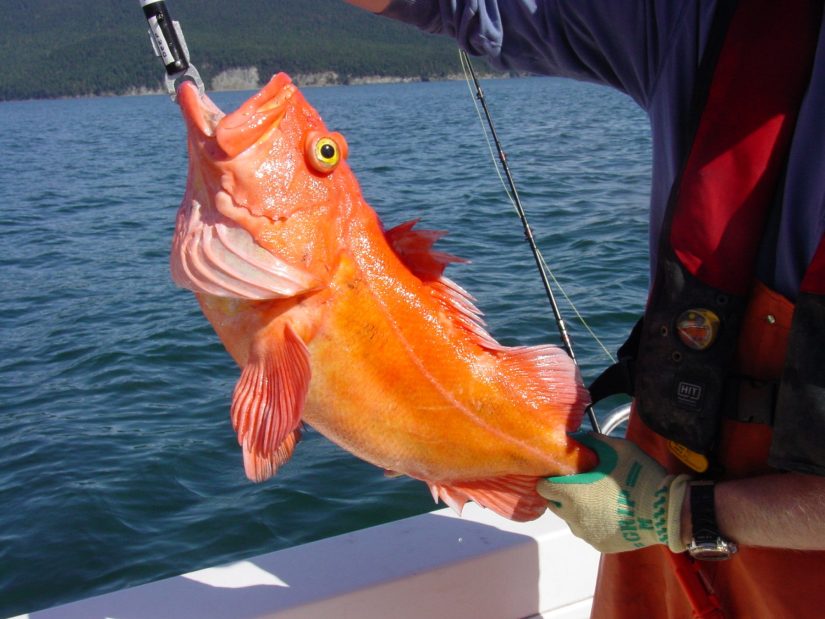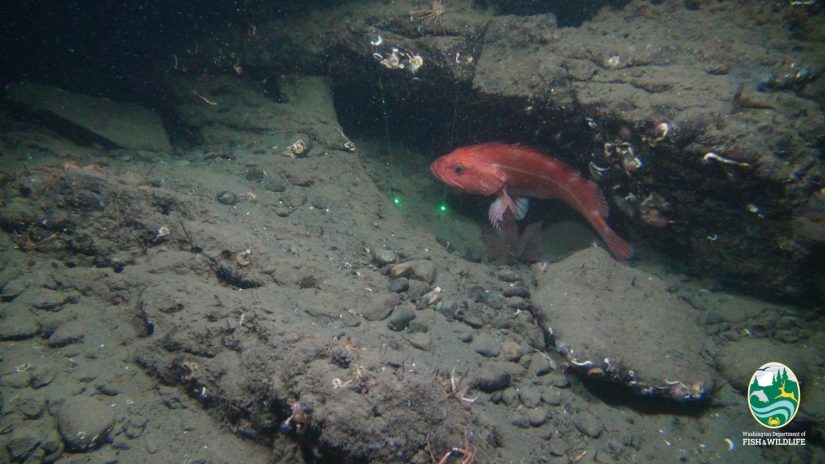Looking to the past to inform the future
Historical ecology and data-limited fisheries stock assessment methods shed light on threatened Puget Sound Yelloweye Rockfish
By applying elements of historical ecology, fisheries science, and conservation biology in a highly collaborative research effort, researchers from the University of Washington School of Aquatic and Fishery Sciences (SAFS), NOAA Fisheries, and the Washington Department of Fish and Wildlife (WDFW) are delivering new insights into the status of Yelloweye Rockfish.
Listed as threatened under the Endangered Species Act (ESA) in 2010, the population of Yelloweye Rockfish (Sebastes ruberrimus) in Puget Sound/Georgia Basin is considered highly vulnerable due to historical fisheries exploitation and climate change. With their namesake yellow eyes and red-orange bodies, Yelloweye Rockfish are among the largest (up to 36” and 40 lbs) and longest living (110+ years) rockfish species.

Since 2017, the distinct population segment (DPS) of this species inhabiting the Puget Sound/Georgia Basin has been managed under a formal federal recovery plan with biological criteria set out to measure recovery: certain levels of spawning potential ratio (SPR). This metric is an indicator of how well the population is doing, expressed as a percentage of its pre-exploitation population size. However, a lack of data has hampered efforts to estimate this key indicator and monitor recovery.
This challenge was recently tackled by a research team led by SAFS PhD student Markus Min, who worked with partners at NOAA Fisheries and the WDFW. To provide more information to inform recovery management actions, the team delved into the exploitation history and population dynamics of the DPS, with results in a new paper published in the journal Marine and Coastal Fisheries in September 2023.

The recovery plan set out by NOAA Fisheries in 2017 focused on SPR, which can be estimated from length compositions. The team at SAFS went a step further and combined length data with a catch history to improve understanding of population dynamics over time. This, in turn, allowed them to estimate a different and more informative measure of stock status, relative (to unfished) spawning stock biomass (SSB), rather than only SPR.
Catches of rockfish in Puget Sound from both the recreational and commercial fisheries have been monitored for decades by the WDFW and its predecessor, the Washington Department of Fisheries. Length data came from several studies in Puget Sound, each with a different purpose. A historical baseline was provided by a survey conducted in the 1970s that sought to understand the biology of various rockfish species caught in the commercial and recreational fisheries, which were expanding at the time. In the 2010s, two studies were conducted to inform the conservation of rockfish – one on the population genetics of Yelloweye Rockfish and other ESA-listed species, and one aimed at understanding how to reduce rockfish bycatch in the recreational lingcod fishery. The distribution of length data from fish caught in these two decades provided two snapshots into the health of the population, spaced forty years apart.

The team reconstructed the catch history of Yelloweye Rockfish from fisheries records, collated the length data from historical and contemporary hook-and-line surveys and fitted a data-limited version of a statistical catch-at-age model. By combining these disparate datasets, the researchers were able to confirm the Yelloweye Rockfish population in Puget Sound was likely highly depleted during the period of concern when the species was initially petitioned for listing under the ESA, and despite a wide range of model uncertainty, the population has a high probability of being above the 25% of unfished spawning potential threshold identified in the recovery plan. This population increase is a result of significant restrictions in both the commercial and recreational fisheries for the past 25 years. While reaching this benchmark is highly encouraging, it addresses only the first criteria in the recovery plan that could lead to delisting; population levels must be maintained for several years to ensure long-term population viability.
Some additional uncertainty remains with regard to population status due to this DPS including Yelloweye Rockfish from South Puget Sound all the way up to the Queen Charlotte Strait in British Columbia. This range means the population falls under different fishery, management, and jurisdictional boundaries, and face variation in key threats. Given the fact that NOAA Fisheries and the WDFW only have jurisdiction over the Puget Sound portion of the DPS, this analysis focused on U.S. waters. In contrast, a commercial fishery for Yelloweye Rockfish still exists in the Georgia Basin portion of the DPS, but a recent Department of Fisheries and Oceans Canada analysis estimated that portion of the population to be at near sustainable levels. In 2020, however, the Committee on the Status of Endangered Wildlife in Canada (COSEWIC) proposed elevating the status of this population from Species of Concern to Threatened due to ongoing ecosystem modifications and climate change.
